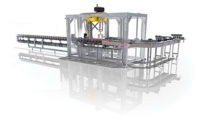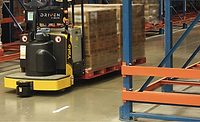Organic, natural beverage distributor boosts productivity with mobile-enabled WMS
Managing picks and shipments through an ERP system

A warehouse worker at a leading natural and organic beverage distributor uses a barcode scanner gun that is integrated to the company’s ERP/WMS system in its 56,000-square-foot warehouse. Four full-time employees across two shifts are dedicated to working on inventory control/management.

This barcode scanner, loaded with data from the JustFoodERP system, is used to receive and pick more than 5,000 SKUs of organic and natural food and beverage products worth approximately $3.5 million.

ONFC employees print barcode label runs larger than 150 labels on these larger thermal printers in the receiving area of the warehouse (shown here). Mobile printers are mounted on some forklifts for fewer labels, and a mobile workstation - comprised of a handheld device and small printer - is wheeled around to where it is needed in the warehouse.

Supervisors interact regularly with the full ERP system in a corner of the warehouse they call the “nerve center” where all setting up of shipments and picks is managed for multiple shifts each day.

To avoid any bin inventory issues, a full “physical” of the warehouse is critical before the ERP go-live, Boris Harmic, IT Manager for ONFC (center), tells industry peers during a 2013 tour of the facility. He adds that significant investment in training time is important to educate pickers on new disciplines related to inventory to reduce the error rate.





To say that the exclusive use of a pen and paper for inventory management was inaccurate would be an understatement, says Boris Harmic, IT manager for the Ontario Natural Food Co-op (ONFC), Mississauga, Ontario. “I could show you a whole book on the change management required to move to a fully automated, digital system,” he says. The major distributor of natural and organic beverages and food went live with a robust, fully integrated warehouse management system (WMS)/enterprise resource planning (ERP) system in late 2012 and still is adding to the system today.
ONFC’s 50,000-square-foot warehouse in Mississauga holds 5,000 SKUs, worth approximately $3.5 million, including several lines from Black River Juice, a company purchased in 2013 by ONFC; almond, rice and coconut beverages from Earth’s Own and Imagine Foods; Evergreen wheatgrass juice; and various juices from Eden Foods, Happy Planet and Fruit Dor.
Approximately 60 people work in three shifts at the ONFC warehouse, 40 of those using handheld barcode scanning guns as well as forklift-mounted tablets that access the WMS/ERP system. “We have a spot in the corner of the warehouse I like to call the ‘nerve center,’” Harmic says. “It’s here that all setting up of shipments and picks is managed for the two shifts each day in the warehouse,” with supervisors interacting with the company-wide ERP system.
ONFC now has four full-time employees, across two of its shifts, working on inventory control and fixes.
“We have ‘cycle counters’ whose sole job is to correct bin inventory,” Harmic explains. “They can work at least an aisle a day, so it takes about a full month to do the entire warehouse. … We are finding problems that we couldn’t before, back when no one was doing proactive cycle counts in this fashion. The replenishment calculator within our ERP system is a neat tool; it will tell you what picking bins require replenishment and where your oldest replacement inventory is located. And I like that the system uses the [first expired, first out] (FEFO) principal for inventory control.
“Right now a lot of onus is being put on the receiving end to do it right, such as assigning lot codes and printing labels,” he continues. ONFC has three ways of label printing: the mobile printer on the forklift can hold up to 150 labels; stationary thermal printers in the receiving area are used for bigger print runs; and mobile workstations, composed of a handheld and small printer, are wheeled around the warehouse.
“We recommend that you don’t go smaller than 4-by-6-inch labels; anything smaller is too finicky for the barcode scanner guns to pick up quickly and easily,” Harmic says. “Also, it’s best to get the longer-range scanner guns, even if they cost slightly more.”
ONFC moved to JustFoodERP in 2012 as its centralized business software system primarily to solve the problems of unsatisfactory fill rates, inaccurate inventory management, and inaccurate manufacturing charge-backs (MCBs). “These are the areas we’ve seen improve the most quickly in the first eight to 12 weeks since our ERP go-live,” Harmic says, noting that his team selected JustFoodERP in part because “other vendors said they would add third-party technologies to the ERP system to meet our requirements. … I didn’t like the smell of that. I wanted a single, integrated ERP system to manage,” including warehousing functionality. Aside from the 40 users in the warehouse, there are 50 desktop users of JustFoodERP across various departments in the ONFC office.
ONFC recently invested in the addition of a Microsoft SharePoint portal so that co-op members, customers and vendors can connect with the ERP system remotely and get the information they need. Additionally, the SharePoint extension allows for more business reporting. “I recommend the addition of SharePoint for any company investing in ERP and WMS technology to extend functionality and business intelligence easily,” Harmic says.
Harmic also has other advice for food distributors thinking of getting a WMS/ERP system. “A full physical of the warehouse is critical before the ERP go-live, otherwise you will have bin inventory issues right from the get-go,” he says. “Significant investment in training time is important to educate pickers on new disciplines related to inventory to reduce the error rate. For example, our pickers needed to be made more aware of the value of what they are handling. The lot traceability component of our new system also required more training.” He adds that “no amount of planning or training can substitute for the volume of a real day’s work, so the piloting phase, just prior to go-live, is very important, as are the first few weeks directly following go-live.”
Looking for a reprint of this article?
From high-res PDFs to custom plaques, order your copy today!












